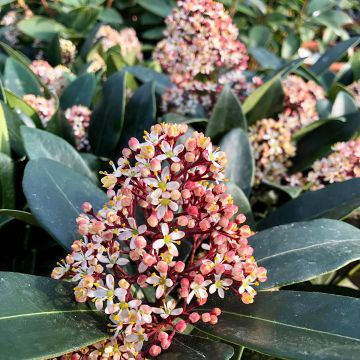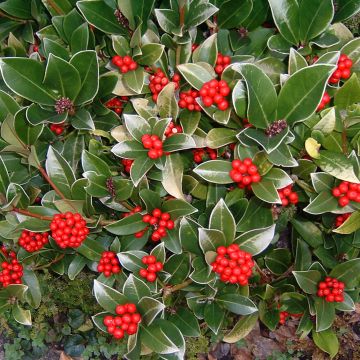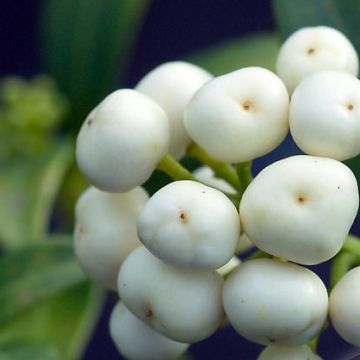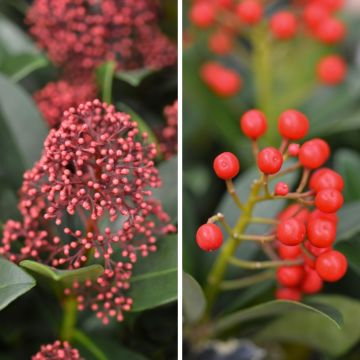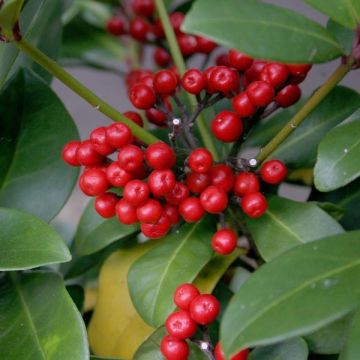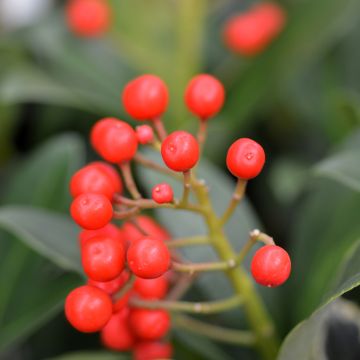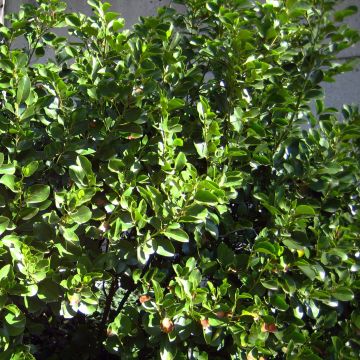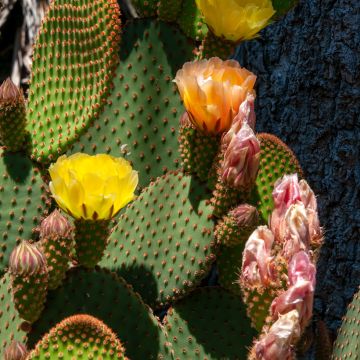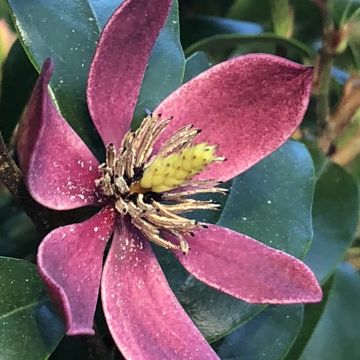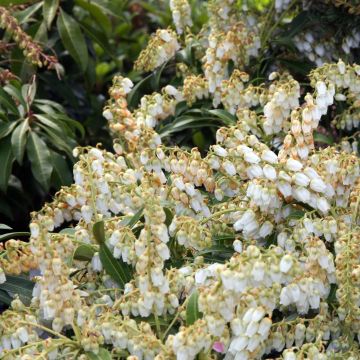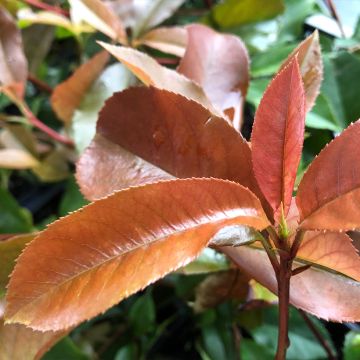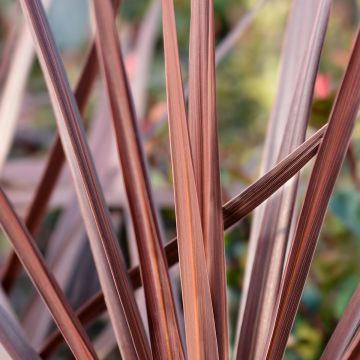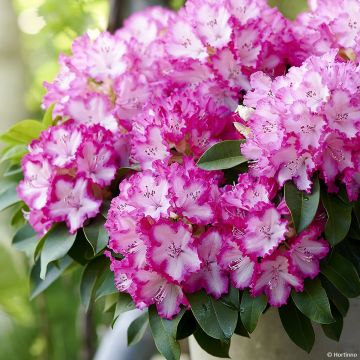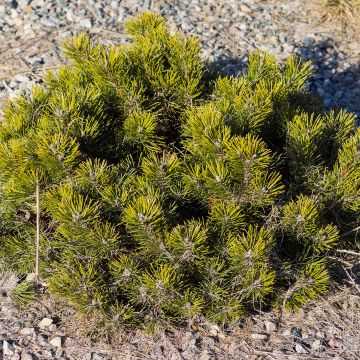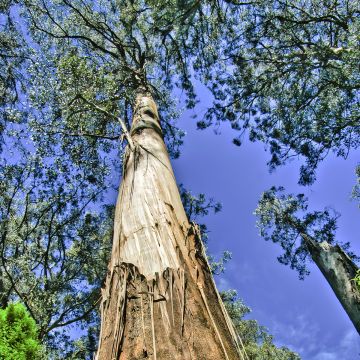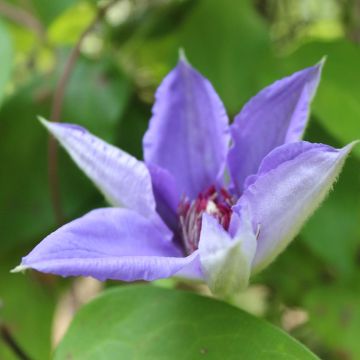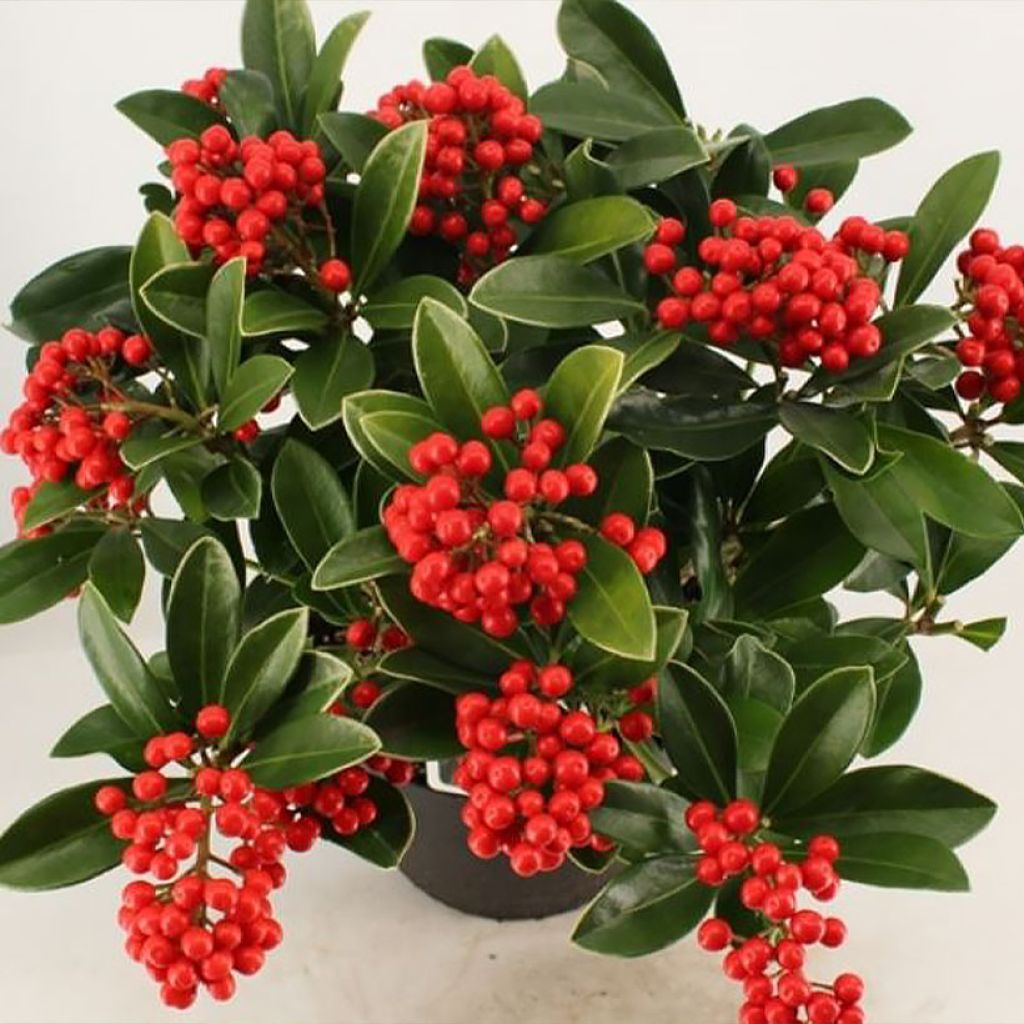

Skimmia japonica Temptation - Japanese Skimmia
Skimmia japonica Temptation - Japanese Skimmia
Skimmia japonica Temptation
Japanese Skimmia, Skimmia, Japanese Skimmia Japonica
This item cannot be shipped to the selected country
Delivery charge from €5.90
More information
Schedule delivery date,
and select date in basket
This plant carries a 24 months recovery warranty
More information
We guarantee the quality of our plants for a full growing cycle, and will replace at our expense any plant that fails to recover under normal climatic and planting conditions.
From €5.90 for pickup delivery and €6.90 for home delivery
Express home delivery from €8.90.
Does this plant fit my garden?
Set up your Plantfit profile →
Description
Skimmia japonica 'Temptation' is a desirable and ornamental variety all year round. This female Skimmia produces a lovely white flowering in spring, which stands out beautifully against the dark green evergreen foliage. The self-fertile flowers then develop to produce ornamental, bright red fruits in autumn, which persist for six months on the plant. In winter, early flower buds appear, which then mingle with the berries to create a stunning scene. Perfect for shaded areas, this compact slow-growing bush thrives in fresh non-calcareous soil. It can also be grown in a pot to enhance a terrace in the most beautiful way.
Skimmia is a member of the Rutaceae family, named after the Rue (Ruta in Latin) and includes over 150 genera, including citrus trees (Citrus and related species). Discovered in Japan by Carl Thunberg in 1780, the Skimmia genus contains about ten species native to the Himalayan regions and Southeast Asia. Its name comes from the Japanese skimmi and is said to mean "fruit that harms" as even birds cannot consume them. Skimmia japonica grows naturally in Japan, on the Russian island of Sakhalin, in Taiwan, and possibly also on the large island of Luzon in the Philippines. It can be found in forests, often developing as an epiphyte on trees, particularly Cryptomerias in Japan. There are male and female plants (dioecious plant), with the males displaying more showy and fragrant flowers and the females producing decorative fruit.
'Temptation' is a female variety, which has the interesting characteristic of being self-fertile, allowing it to bear fruit even in the absence of a male plant for pollination. The bush is compact and very dense, slow-growing, forming at maturity a more or less regular ball 90 cm to 1 m high with an equivalent width. The lanceolate leaves measure from 7 to over 10 cm long and are dark green with a visible lighter central vein. The leathery leaves are covered with a waxy cuticle that gives them a satin-like, almost glossy appearance. After rain, water forms droplets on the surface of the leaves, enhancing their shiny look. During winter, white flower buds form to bloom from mid-April. Corymbs of small flowers then rise slightly above the foliage, creating a lovely contrast. The slightly fragrant flowers shaped like small white stars are also honey-producing, adding a utilitarian appeal to this ornamental bush. Once pollinated, the flowers transform to produce clusters of very attractive bright red berries in autumn. These fruits are unattractive to birds, create a magnificent contrast against the dark foliage and persist throughout winter on the plant. They then coexist with the new flower buds, forming an irresistible trilogy in green, red, and white.
Skimmia japonica 'Temptation' is a little gem that truly deserves its name as it's so attractive. Its compactness allows it to be grown in a pot if the soil in your garden is calcareous or if your climate is too harsh in winter, allowing you to shelter it during severe frosts. In the ground, sheltered from the sun by the shade of taller plants, you can grow it with acid soil plants. At the edge of the bed, plant even lower plants, such as Andromeda polifolia 'Compacta', a dwarf Andromeda that will form a small cushion of 40 cm in all directions, whose fine dark green foliage is adorned with small pale pink bells from April to June. In the second row, alongside your Skimmia, plant Kalmia latifolia 'Olympic Fire', an unjustly overlooked shrub, known as Mountain Laurel, whose spring flowering in pink and white, both architectural and colourful, will enchant you. And in the background, another rare gem, Oxydendron arboreum, a medium-sized shrub with a very natural habit, which shines both for its summer flowering in long clusters of white bells and for its deciduous foliage that ignites red in autumn.
Report an error about the product description
Plant habit
Flowering
Foliage
Botanical data
Skimmia
japonica
Temptation
Rutaceae
Japanese Skimmia, Skimmia, Japanese Skimmia Japonica
Cultivar or hybrid
Other Skimmia
Planting and care
Plant Skimmia japonica 'Temptation' in partial shade or shade in humus-bearing, moist yet well-drained soil, preferably acidic. Ericaceous soil mixed with leaf mould is ideal. Avoid direct sunlight and alkaline, calcareous, poor, and dry soils, as well as heavy soil to prevent chlorosis and brown spots. Soak the root ball for a quarter of an hour in a bucket of water before planting, then once in place, water generously. Water regularly, especially in summer, as this plant does not like dryness. Place your Skimmia sheltered from strong winds and cold drafts, under the shade of other plants. Skimmia japonica may be attacked by scale insects.
Planting period
Intended location
Care
This item has not been reviewed yet - be the first to leave a review about it.
Evergreen shrubs
Haven't found what you were looking for?
Hardiness is the lowest winter temperature a plant can endure without suffering serious damage or even dying. However, hardiness is affected by location (a sheltered area, such as a patio), protection (winter cover) and soil type (hardiness is improved by well-drained soil).

Photo Sharing Terms & Conditions
In order to encourage gardeners to interact and share their experiences, Promesse de fleurs offers various media enabling content to be uploaded onto its Site - in particular via the ‘Photo sharing’ module.
The User agrees to refrain from:
- Posting any content that is illegal, prejudicial, insulting, racist, inciteful to hatred, revisionist, contrary to public decency, that infringes on privacy or on the privacy rights of third parties, in particular the publicity rights of persons and goods, intellectual property rights, or the right to privacy.
- Submitting content on behalf of a third party;
- Impersonate the identity of a third party and/or publish any personal information about a third party;
In general, the User undertakes to refrain from any unethical behaviour.
All Content (in particular text, comments, files, images, photos, videos, creative works, etc.), which may be subject to property or intellectual property rights, image or other private rights, shall remain the property of the User, subject to the limited rights granted by the terms of the licence granted by Promesse de fleurs as stated below. Users are at liberty to publish or not to publish such Content on the Site, notably via the ‘Photo Sharing’ facility, and accept that this Content shall be made public and freely accessible, notably on the Internet.
Users further acknowledge, undertake to have ,and guarantee that they hold all necessary rights and permissions to publish such material on the Site, in particular with regard to the legislation in force pertaining to any privacy, property, intellectual property, image, or contractual rights, or rights of any other nature. By publishing such Content on the Site, Users acknowledge accepting full liability as publishers of the Content within the meaning of the law, and grant Promesse de fleurs, free of charge, an inclusive, worldwide licence for the said Content for the entire duration of its publication, including all reproduction, representation, up/downloading, displaying, performing, transmission, and storage rights.
Users also grant permission for their name to be linked to the Content and accept that this link may not always be made available.
By engaging in posting material, Users consent to their Content becoming automatically accessible on the Internet, in particular on other sites and/or blogs and/or web pages of the Promesse de fleurs site, including in particular social pages and the Promesse de fleurs catalogue.
Users may secure the removal of entrusted content free of charge by issuing a simple request via our contact form.
The flowering period indicated on our website applies to countries and regions located in USDA zone 8 (France, the United Kingdom, Ireland, the Netherlands, etc.)
It will vary according to where you live:
- In zones 9 to 10 (Italy, Spain, Greece, etc.), flowering will occur about 2 to 4 weeks earlier.
- In zones 6 to 7 (Germany, Poland, Slovenia, and lower mountainous regions), flowering will be delayed by 2 to 3 weeks.
- In zone 5 (Central Europe, Scandinavia), blooming will be delayed by 3 to 5 weeks.
In temperate climates, pruning of spring-flowering shrubs (forsythia, spireas, etc.) should be done just after flowering.
Pruning of summer-flowering shrubs (Indian Lilac, Perovskia, etc.) can be done in winter or spring.
In cold regions as well as with frost-sensitive plants, avoid pruning too early when severe frosts may still occur.
The planting period indicated on our website applies to countries and regions located in USDA zone 8 (France, United Kingdom, Ireland, Netherlands).
It will vary according to where you live:
- In Mediterranean zones (Marseille, Madrid, Milan, etc.), autumn and winter are the best planting periods.
- In continental zones (Strasbourg, Munich, Vienna, etc.), delay planting by 2 to 3 weeks in spring and bring it forward by 2 to 4 weeks in autumn.
- In mountainous regions (the Alps, Pyrenees, Carpathians, etc.), it is best to plant in late spring (May-June) or late summer (August-September).
The harvesting period indicated on our website applies to countries and regions in USDA zone 8 (France, England, Ireland, the Netherlands).
In colder areas (Scandinavia, Poland, Austria...) fruit and vegetable harvests are likely to be delayed by 3-4 weeks.
In warmer areas (Italy, Spain, Greece, etc.), harvesting will probably take place earlier, depending on weather conditions.
The sowing periods indicated on our website apply to countries and regions within USDA Zone 8 (France, UK, Ireland, Netherlands).
In colder areas (Scandinavia, Poland, Austria...), delay any outdoor sowing by 3-4 weeks, or sow under glass.
In warmer climes (Italy, Spain, Greece, etc.), bring outdoor sowing forward by a few weeks.

































